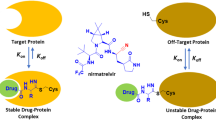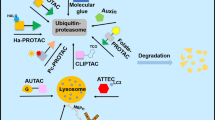Abstract
Covalent inhibition has recently gained a resurgence of interest in several drug discovery areas. The expansion of this approach is based on evidence elucidating the selectivity and potency of covalent inhibitors when bound to particular amino acids of a biological target. The Nedd4-1, an E3 ubiquitin ligase, is characterized by two covalent binding sites, of which catalytic Cyscat and allosteric Cysallo are enclosed. This enzyme has demonstrated inhibition at both the above-mentioned binding sites; however, a detailed molecular understanding of the structural mechanism of inhibition upon Cyscat and Cysallo binding remains vague. This prompted us to provide the first account of investigating the preferential covalent binding mode and the underlying structural and molecular dynamic implications. Based on the molecular dynamic analyses, it was evident that although both catalytic and allosteric covalent binding led to greater stability of the enzyme, a preferential covalent mechanism of inhibition was seen in the allosteric-targeted system. This was supported by a more favorable binding energy in the allosteric site compared to the catalytic site, in addition to the larger number of residue interactions and stabilizing hydrogen bonds occurring in the allosteric covalent bound complex. The fundamental dynamic analysis presented in this report compliments, as well as adds to previous experimental findings, thus leading to a crucial understanding of the structural mechanism by which Nedd4-1 is inhibited. The findings from this study may assist in the design of more target-specific Nedd4-1 covalent inhibitors exploring the surface-exposed cysteine residues.







Similar content being viewed by others
References
Reyes-Turcu FE, Ventii KH, Wilkinson KD (2009) Annu Rev Biochem 78:363–397
Bhogaraju S, Dikic I (2016) Nature 533:43–44
Rotin D, Kumar S (2009) Nat Rev Mol Cell Biol 10:398–409
An H, Krist DT, Statsyuk AV (2014) Mol BioSyst Mol BioSyst 10:1643–1657
Kathman SG, Span I, Smith AT, Xu Z, Zhan J, Rosenzweig AC, Statsyuk AV (2015) J Am Chem Soc 137:12442–12445
Edwin F, Anderson K, Patel TB (2010) J Biol Chem 285:255–264
Ingham RJ, Gish G, Pawson T (2004) Oncogene 23:1972–1984
Zou X, Levy-cohen G, Blank M (2015) BBA - Rev Cancer 1856:91–106
Gallo LH, Ko J, Donoghue DJ (2017) Cell Cycle 16:634–648
Diehl JA, Fuchs SY, Haines DS (2010) Genes Cancer 1:679–680
Porter CT, Bartlett GJ, Thornton JM (2004) Nucleic Acids Res 32:D129–D133
Kenakin T (2007) Curr Neuropharmacol 5:149–156
Changeux J, Edelstein SJ (2005) Science. https://doi.org/10.1126/science.1108595
Schwab A, Illarionov B, Frank A, Kunfermann A, Seet M, Bacher A, Witschel MC, Fischer M, Groll M, Diederich F (2017) ACS Chem Biol 12:2132–2138
Berman HM, Westbrook J, Feng Z, Gilliland G, Bhat TN, Weissig H, Shindyalov IN, Bourne PE (2000) Nucleic Acids Res 28:235–242
Pettersen EF, Goddard TD, Huang CC, Couch GS, Greenblatt DM, Meng EC, Ferrin TE (2004) J Comput Chem 25:1605–1612
Technologies I, Molegro Molecular Viewer, http://molegro-molecular-viewer.software.informer.com
Morris GM, Huey R, Lindstrom W, Sanner MF, Belew RK, Goodsell DS, Olson AJ (2009) J Comput Chem 30:2785–2791
Trott O, Olson AJ (2009) J Comput Chem 31:NA-NA
Madhavi Sastry G, Adzhigirey M, Day T, Annabhimoju R, Sherman W (2013) J Comput Aided Mol Des 27:221–234
Mhlongo NN, Ebrahim M, Skelton AA, Kruger HG, Williams IH, Soliman MES (2015) RSC Adv 5:82381–82394
Ramharack P, Oguntade S, Soliman MES (2017) RSC Adv 7:22133–22144
Götz AW, Williamson MJ, Xu D, Poole D, Le Grand S, Walker RC (2012) J Chem Theory Comput 8:1542–1555
Lindorff-Larsen K, Piana S, Palmo K, Maragakis P, Klepeis JL, Dror RO, Shaw DE (2010) Proteins 78:1950–1958
Betz R (2017) Dabble. Zenodo. https://doi.org/10.5281/ZENODO.836914
Jorgensen WL, Chandrasekhar J, Madura JD, Impey RW, Klein ML (1983) J Chem Phys 79:926–935
Hopkins CW, Le Grand S, Walker RC, Roitberg AE (2015) J Chem Theory Comput 11:1864–1874
Khan S, Bjij I, Betz RM, Soliman ME (2018) Future Med Chem 10:1003–1015
Roe DR, Cheatham TE (2013) J Chem Theory Comput 9:3084–3095
Seifert E (2014) J Chem Inf Model 54:1552–1552
Parak FG (2003) Curr Opin Struct Biol 13:552–557
Zhang H, Zhang T, Chen K, Shen S, Ruan J, Kurgan L (2009) Proteins 76:617–636
Ragone R (2001) Protein Sci 10:2075–2082
Vanga SK, Singh A, Raghavan V (2015) Innov Food Sci Emerg Technol 30:79–88
Acknowledgements
We would like to acknowledge the Center for High Computing Performance (CHPC) (http://www.chpc.ac.za), Cape Town for resources and technical support as well as the College of Health Sciences for the financial support. R.M.B is supported by NVIDIA fellowship.
Author information
Authors and Affiliations
Corresponding author
Ethics declarations
Conflict of interest
The authors declare no conflicts of interest.
Electronic supplementary material
Below is the link to the electronic supplementary material.
Rights and permissions
About this article
Cite this article
Bjij, I., Khan, S., Betz, R. et al. Exploring the Structural Mechanism of Covalently Bound E3 Ubiquitin Ligase: Catalytic or Allosteric Inhibition?. Protein J 37, 500–509 (2018). https://doi.org/10.1007/s10930-018-9795-5
Published:
Issue Date:
DOI: https://doi.org/10.1007/s10930-018-9795-5




